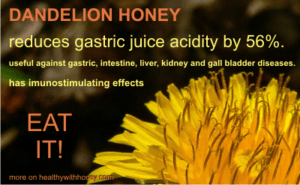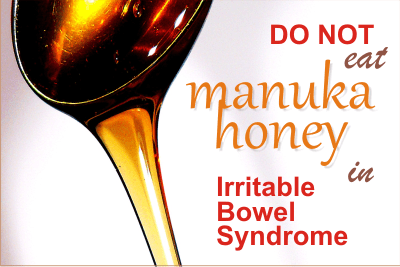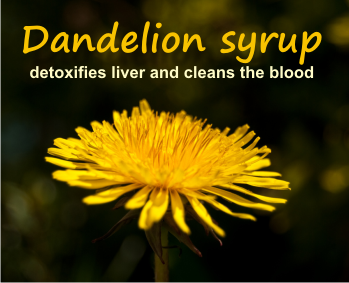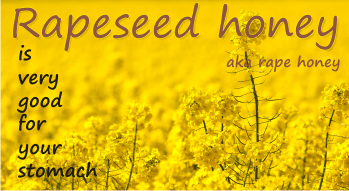Real dandelion honey is well known for its health benefits, though this type of honey is quite rare. I say “real” because there is another type of “dandelion honey” which is made by humans, not by honey bees. If you manage to find real dandelion honey, buy it and enjoy it with much appreciation, because it will be your body’s friend.
Let’s see what’s with this plant.
Name: Dandelion (Taraxacum officinale)
Family: Asteraceae
Other names: Lion’s tooth, Priest’s crown, Swine’s snout
Grows in: temperate regions of Europe, Asia, and North America.
Height: nearly 12 inches. Dandelion is a hardy perennial. A stubborn weed, we can say.
Leaves: deeply-notched, toothy, spatula-like leaves, shiny and hairless. The grooved leaves funnel rain to the root.
Flowers: bright yellow flowers which respond to sun and dark. They open with the sun in the morning and close in the evening or during gloomy weather.
Roots: fleshy and brittle, filled with a white milky substance that is bitter and slightly smelly.
Health benefits of dandelions:
This wonderful weed is full of vitamins A, B, C, and D, as well as minerals, such as iron, potassium, and zinc. It also contains flavonoids such as luteolin, apigenin and isoquercitrin (a quercetin-like compound), as well as caffeic and chlorogenic acid. Dandelion also contains terpenoids, triterpenes, and sesquiterpenes.
In the kitchen, dandelion is used a lot.
– leaves are very muchloved by vegetarians, they using them in salads, sandwiches, and teas.
– roots are used in some coffee substitutes,
– flowers are used to make wine and syrup. The beautiful yellow flowers are familiar to all nannies, who make incredible “dandelion honey” and use it in spring, when the real honey has not yet been extracted. Every child loves it on toast and butter, in the morning. (To see how it is done, please read How to make dandelion honey. What is it good for?)
In medicine, dandelions have been used since ancient times.
Records of dandelion’s cultivation go back as far as 10th century Arabia. They used its roots, dried them out and used it to make an invigorating taste-rich tea.
Roots and leaves: were used to treat liver problems.
– Native Americans were boiling dandelions in water and then taking them treat kidney disease, swelling, skin problems, heartburn, and upset stomach.
– In traditional Chinese medicine, dandelion has been used to treat stomach problems, appendicitis, and breast problems, such as inflammation or lack of milk flow.
– In Europe, dandelion was used in remedies for fever, boils, eye problems, diabetes, and diarrhea.
Today, dandelion is supported by pharmacological investigations, especially concerning its help in treating digestive disorders.
Herbal medicine uses it:
– to treat infections,
– to treat bile and liver problems,
– as a diuretic.
– as a mild laxative,
– for increasing appetite,
– as a plant bitter for improving digestion.
– to cure warts (the milky latex)
With very low or even no toxicity at all, dandelion can be drunk as tea on a daily basis.
Any studies?
Most scientific studies of dandelion have been made on animals, not people.
· Here is a study showing the effects of dandelion extracts of anti-physical fatigue in mice.
· This study shows that dandelion extracts may be very useful in treating obesity, by playing a significant role during adipogenesis and lipid metabolism.
· This study reveals that dandelion might be suitable for tissue engineering applications, on account of the combined activity of polyphenols and collagen.
The list of studies is really long to be put here. They all show the good effects of dandelion for our entire health, especially concerning diabetes, physical energy levels (stamina), skin elasticity and hydration, osteoclastogenesis effects and others.
As for curing cancer, the list is again very long. See here. But I need to mention the almost miraculous healing of leukemia with dandelion root tea.
Can we buy dandelions extracts?
Dandelion can be found as tinctures, liquid extract, teas, tablets, and capsules.
Be careful that in some people, dandelion may cause increased stomach acid and heartburn. It may also irritate the skin and interact with some medication.
Also, there have been reported some cases (especially in Japan) of dandelion honey allergy. Take it easy and notice any unusual symptom before swallowing 3 spoonfuls per day.
Dadendelion makes a reliable component in any herbal mix tea for detoxifying the body. See this tea sold on Amazon.com: 14-Day Detox Tea by Hint Wellness (43g) – Skinny Tea Detox and Body Cleanse Aids Weight Loss, Reduces Bloating and Improves Digestion – Delicious, Premium Quality Loose Leaf Herbal Detox Blend.

Find put more about the health benefits of this amazing plant in the article:
How to make “dandelion honey”.
Dandelion honey
Crystallizes quickly, because its nectar (like rape) consists predominantly of fructose and glucose. Fabiaceae and Labiateae plants (like acacia, clover, sage, lavender) have nectar containing mainly sucrose.
Dandelion honey is quite rare, as it is among the first flowers that bloom in spring (from April to May) and honey bees need this honey as food for themselves, to strengthen their family. That’s why beekeepers leave it in the hive, so the bees can feed on it and get strong in preparation for subsequent types of blossoms. Besides, it crystallizes very quickly (due to high glucose content) so it is not easy to extract.

Color: from intense golden yellow to a darker hue as it crystallizes. A vivid yellow color indicates great purity.
Taste: a pungent, sharp and strong taste, with medium sweetness and a slightly astringent lingering aftertaste, often described as refreshing.
Aroma: reminiscent of the flower itself but stronger like an essential oil of dandelion. The aroma is described as ammonia, chamomile, vinegar, animal glue and apparently can be initially repellent for those unfamiliar with this honey. Some say it’s woody and spoiled.
Persistence/aftertaste: long
Sweetness: medium
Bitterness: absent to weak
Crystallization: rapidly, due to the high glucose content. When it is crystallised, with very small crystals, it has a refreshing (like “fondant”) taste.
Pollen content: pollen of Taraxacum does not seem to be under-represented, however its percentage in the honey rarely goes beyond 50%,
Electrical Conductivity: 0.51
Acidity: low
Glucose: high levels 38 g/100 g
Fructose: 37.4 g/100 g
Sucrose: 0.4 g/100 g
pH: 4.5
Water content: 16.2 g/100 g
Diastase: 11.3 DN
Invertase: 110.7 U/kg
Proline: 348 mg/ kg
Read more on the composition of honey: antioxidants, polyphenols, vitamins, enzymes.
Constituents: According to the study Comparison of different methodologies for detailed screening of Taraxacum officinale honey volatiles, by Jerković et al., from 2015, dandelion honey has a different composition than expected. “The extracts contained phenylacetic acid (up to 24.0%) and dehydrovomifoliol (up to 19.3%) as predominant compounds, while 3-methylpentanenitrile and phenylacetonitrile were detected in the extracts in minor abundance. Dehydrovomifoliol can be considered more characteristic for dandelion honey in distinction from phenylacetic acid. Low molecular aliphatic acids, benzene derivatives and an array of higher aliphatic compounds were also found in the extracts.”
In Italy, dandelion is known as soffione, tarassaco or lion’s tooth, and there is a tradition in harvesting dandelion honey. To be considered dandelion monofloral honey, it must contain at least 5% of dandelion pollen. It is produced mainly in the areas of Saluzzo and Upper Cuneese and it features a strong color and aroma. But the production is not always constant as dandelion blossoms in early April and can be subjected to spring frosts.
This honey, together with its various therapeutic properties, also has the quality to be an excellent table honey. It has a creamy, buttery texture that suits application on toast and this combination makes a fine morning treat.
Dandelion honey health benefits

1. It has imunostimulating effects
Apalbumine 1, the dominant royal jelly in honey with immunostimulating properties, is present in unifloforal honeys in different quantities. The quantity of apalbumine (and thus its immunostimulating effects) decreases in the following order: Chestnut >Dandelion > Rape > Linden > Acacia. So, coming right after chesnut honey, dandelion honey is a recommended honey to strengthen your immune system.
2. It is used against gastric, intestine, liver, kidney and gall bladder diseases.
Dandelion honey helps the liver and kidneys to do their work and keeps the bowels in a healthy condition, particularly important to dyspeptics (persons who suffer from indigestion or irritability) as it does not cause wakefulness.
According to BALTUSKEVICIUS et al, in a study from 2001, the ingestion of dandelion honey was shown to reduce gastric juice acidity by 56%. The gastric emptying of saccharides after ingestion of honey was slower than that of a mixture of glucose and fructose (according to POKORN, D in 1978).
Couldn’t you find real dandelion honey anywhere?
If you don’t have it, but still want to benefit from the good effects of dandelion on your body, and want to be able to eat it, but you don’t have time to boil the tea, just make your own dandelion honey, actually a dadelion syrup. You can find the DIY steps here: How to make dandelion honey. What is it good for?
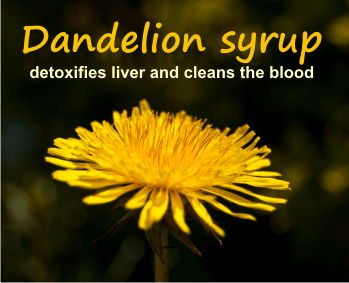
************************
************************
References:
– Dandelion flower – picture by Greg Hume – Own work, CC BY-SA 3.0, https://commons.wikimedia.org/w/index.php?curid=17890515
– drawing of dandelion – picture by Franz Eugen Köhler, Köhler’s Medizinal-Pflanzen – List of Koehler Images, Public Domain, https://commons.wikimedia.org/w/index.php?curid=255466
– http://umm.edu/health/medical/altmed/herb/dandelion
– http://www.honeytraveler.com/single-flower-honey/dandelion/
– BALTUSKEVICIUS, A; LAISKONIS, A; VYSNIAUSKIENE, D; CEKSTERYTE, V; RACYS, J (2001) Use
of different kinds of honey for hepatitis A treatment and for reduction of increased acidity of gastric
juice. Zemdirbyste, Mokslo Darbai 76: 173-180.
– POKORN, D; VUKMIROVIC, V (1978) Velocity of gastric emptying of saccharides after administering
honey, apicompleks and pure invert sugar, IIIe Symposium International d’Apitherapie, 11-15
Septembre 1978, Portoroz, Yougoslavie, Apimondia, Bukarest, 1978: pp 277-279.
– Main European unifloral honeys: descriptive sheets, Apidologie 35 (2004) S38–S81 © INRA/DIB-AGIB/ EDP Sciences, 2004, DOI: 10.1051/apido:2004049;

